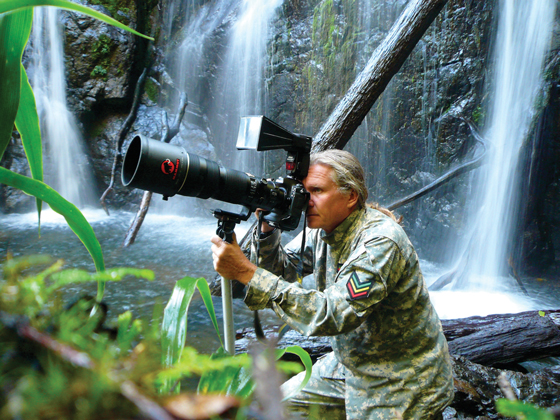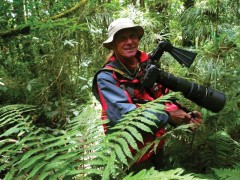Oliver Thor Janson

First seen in 1973, he became a common jungle personage. Like Lord Greystoke, he was suckled by the wild beasts, crowned his head with the iridescent feathers of quetzal, and drank directly from the fountains of origin. Navigator, explorer, biologist, photographer, author, synergetic geometrician, he walked in boustrophedon the four cardinal points, leaving testimony of his path everywhere. —Sensei Manuel Corleto
Oliver Thor Janson is a wildlife conservationist who uses photography as a tool to promote environmental education, his life passion.
Born in Chicago, the son of a Swedish immigrant father and an Irish-Chippewa Indian mother, Thor began his career as an explorer at the age of four when he ventured out on his tricycle far beyond the home territory. At the police station, he was asked to reveal the names of his parents but little Ollie could only repeat the names of the two beloved dogs who had raised him: “Jimi, Pepe, Jimi, Pepe.”
Childhood was spent between Chicago and the forests of Northern Michigan. Ollie took an early interest in nature studies and loved to keep snakes as pets. From the age of six Ollie summered at Camp Charlevoix in the pristine boreal forest near Traverse City.
One dawn, he hurried down for the daily reveille, flag raising and inspection by the lake shore and stood in a line with the 300 other scouts. Inspection involved the camp nurse checking to see if your fingernails and ears were clean. When she came to little Ollie she suddenly screamed at the top of her lungs. A water snake, which he hadn’t had time to put back in its popsicle-stick house, was poking its head out from the neck of Ollie’s T-shirt. This funny event became a permanent part of Charlevoix’s camp lore.
At university, young Janson focused on biology and music. At Schiller International University in Berlin, he studied music theory under the famous organist Gerhard Blum. At Southern Illinois University, he focused on experimental electronic music and forestry. At the University of San Francisco, he entered a pre-med program and studied oceanography, publishing a paper on Holothurians and the life of deep ocean trenches.
“It seemed like the primary focus of most of my colleagues was simply how to get themselves set up for maximum money making, not liberating their fellow human beings from the oppression of disease. To take advantage of people when they are down—when they are sick—in order to extract as much money from them as they can bear, that seemed wrong to me. Such an attitude is not likely to endear a young student to the medical faculty. So I decided to resign from the university, hop on my Honda 350 motorcycle, and tune in to the wild blue yonder … heading south … destination unknown!”
 It was during this, his first trip around the world in 1973, that Janson visited Guatemala, where he lived for a time with a Kaqchikel Indian family in a dirt-floor hut by the shores of Lake Atitlán. “These humble Mayan people taught me that happiness cannot be bought with money; happiness is a quality of the spirit.”
It was during this, his first trip around the world in 1973, that Janson visited Guatemala, where he lived for a time with a Kaqchikel Indian family in a dirt-floor hut by the shores of Lake Atitlán. “These humble Mayan people taught me that happiness cannot be bought with money; happiness is a quality of the spirit.”
Janson continued around the world, sailing to the most remote islands of Polynesia, working in New Zealand, trekking across Africa and Asia and finally returning to California. “I knew within minutes of stepping on American soil that I would not stay there. It was just too civilized. I guess I had gone native somewhere in the jungles of Mesoamerica. But where would I go? I remembered the happy times I had spent with the Maya in Guatemala and was determined to return.”
It was February of 1976 and Janson was working in Chicago to get some traveling money together when the news of the devastating earthquake in Guatemala came over the wire. As soon as he could, he returned to the land of the Maya to assist in the reconstruction.
That fall he met and became friends with Professor Mario Dary, Director of San Carlos University’s School of Biology, who invited him to join the faculty, where Janson instigated a project to study and protect the endangered manatee. Janson’s project led to the establishment of the Chocón-Machacas Manatee Reserve at Río Dulce, where he was to be the park director.
In 1982, Janson established his own conservation group, Defensores de la Naturaleza, where he remained as director until 1987. Dissatisfied with the government’s handling of forest conservation, he spearheaded an innovative program to open the way for a private organization to manage wild lands with private-sector funding.
His project resulted in the establishment of the Sierra de las Minas Biosphere Reserve, which is managed by Defensores. At present, Janson is focused on protecting the quetzal and its habitat and is director of the Cloud Forest Defense Project.
Hi Thor!!!
I remember you when you were a spanish student at PROYECTO LILA.
I was one of your teachers there.I’m EMILIO and I used to ive very near our spanish school.It’s 1973-74.
I wish you could answer to this mail.
I’m living in Montreal now.I do among other things, ART (luis alvarado anzueto on facebook..)
I want to tell you more about my canadian adventure!!! since 1977!!!!
HOLA TORHTUGA!
TENIA TIEMPO DE NO SABER DE TUS HUESOS, ALGO MAS DE TRES AÑOS (LO QUE TIENE MI PADRE DE HABER MUERTO), Y NOS EXTRAÑO MUCHO NO SABER DE TI EN ESOS DIAS TAN LAMENTABLES PARA NOSOTROS Y SABIENDO EL CARIÑO QUE LE TENIAS A PAPA,TAMBIEN PARA VOS. ESPERO ESTEN BIEN EN LO TUYO
SALUDOS!!!
MANUEL CORLETO JR.